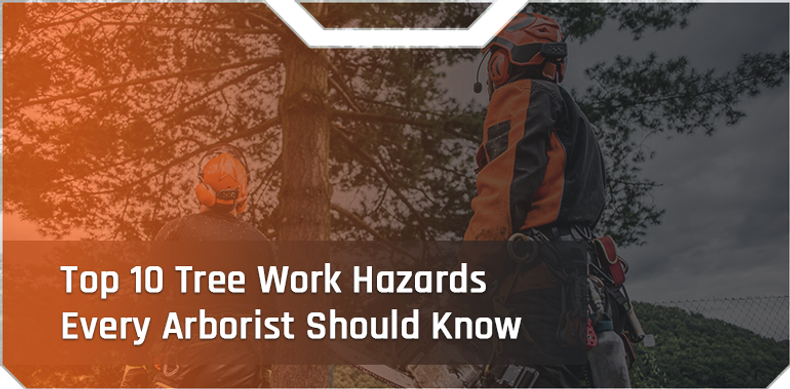It is no secret that Tree Work is dangerous. Climbing into trees with sharp tools, sometimes hundreds of feet into the air, is not for the faint of heart.
If you are an Arborist, you already know the risks of this type of work. It is likely that you have already seen injuries on the job.
If you are looking into becoming an Arborist, you should take some time to learn about the hazards of this kind of work. This list is not intended to scare you away from Tree Work, but rather to make sure that you understand what you are getting into.
Related Article: Avoiding The Arborist Horror Show: Top Ten Ways To Prevent Hazards In Tree Work
1. Faulty Gear
Anytime you are getting ready to climb a tree, you will want to closely inspect all of your gear, from your ropes, to your hardware and PPE.
All Arborist Gear has a “Cycle To Failure,” meaning that it has a limited shelf life before it ceases living up to safety standards. Be aware of the CTF of all of your gear and check your gear for wear damages before starting every job.
Aside from older gear, you also want to inspect new gear for any defects in its construction. Even new gear can unfortunately have faults.
2. Swinging Limbs & Branches
Tree limbs and branches can be real sons-of-a-you-know-what.
They are unpredictable and if you get whacked with one, it can cause serious injuries. Whether it knocks you over or hits you over the head, you may be hurt really badly.
3. Powerlines
Working near power lines is maybe the most dangerous part of the Arborist Way Of Life. Even with very strict regulations in place from OSHA regarding working within proximity of power lines, shock and electrocution still make up a significant portion of injuries and fatalities associated with Tree Work.
The Ten Foot Rule, or Minimum Approach Distance Standards should always be followed on a job. This means that nobody who isn’t specially certified to do Tree Work in close proximity to power lines should ever be working within ten feet of a line.
4. Falling Debris & Tools
If you are working below another Tree Climber, falling debris and tools are pretty serious hazards. Even if you are working above the rest of your crew, objects can sometimes fall on you, putting you in danger.
5. Energized Trees & Limbs
Just like power lines, trees and their limbs can become significant electrical hazards when they come into contact with a power source or are struck by lightning.
It is especially important to remember that limbs that have been compacted can store energy for long periods of time.
6. Heart Attacks
The stress and anxiety associated with working high up in trees combined with the physical strain of climbing and doing physical labor puts Arborists at high risk for heart attacks.
As you may imagine, having a heart attack in a tree is no picnic. Getting your heart health checked regularly, eating better food, and managing stress are all important factors to preventing this kind of horror.
7. Weak Limbs And Tree Decay
Inspecting a tree before every climb is just as important as inspecting all of your gear. Trees can have weak spots that are not obvious at first glance.
Mold, decay, age, fungus, and pest infestation can all weaken limbs and the overall structure of trees.
8. Insects & Other Animals
Speaking of insects, how do you like bees and hornets? What about raccoons, possums, and rats? These are all types of friends from the wild kingdom you can make as an Arborist.
Some of these animals are just kind of gross, some of them are annoying, and some of them are downright dangerous.
9. Less Obvious Electrical Hazards
We already talked about power lines, but there are other electrical hazards that are much less obvious.
Telephone lines, street lamps, and distribution lines are all things you will need to think about, along with water and humidity around power sources.
10. Chainsaw Injuries
We maintain that working with chainsaws is one of the most terrifying parts of Arborist Work. We have an entire article just about Tips For Working With Chainsaw Lanyards, just to give you an idea about how dangerous these tools are.
It really is not that hard to imagine how someone could lose a limb or two while working with a chainsaw while working in trees if you are not extremely careful.
Closing Thoughts
Arborist Work and Tree Work in general is extremely respectable, honest work. If you plan on getting involved in this line of work, you will be in good company. It requires bravery and knowledge of both trees and safety standards, as well as physical strength.
The dangers that come along with the job are facts of life that need to be accepted by anyone getting involved with Arboriculture. If you are an Arborist or someone looking to become an Arborist, we hope that you stay safe on the job and remember to respect all of the guidelines that are designed to get you home in one piece every night!





